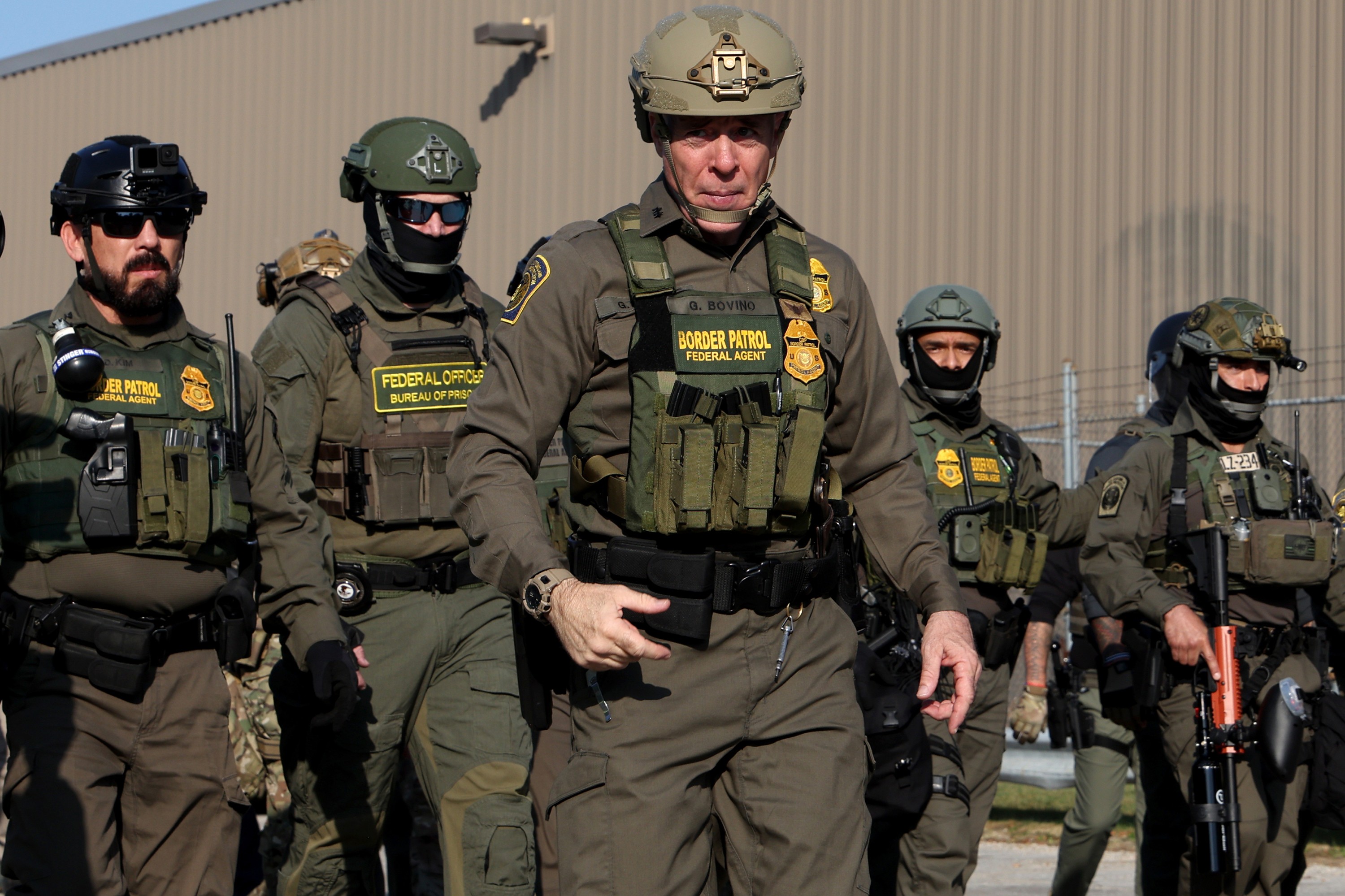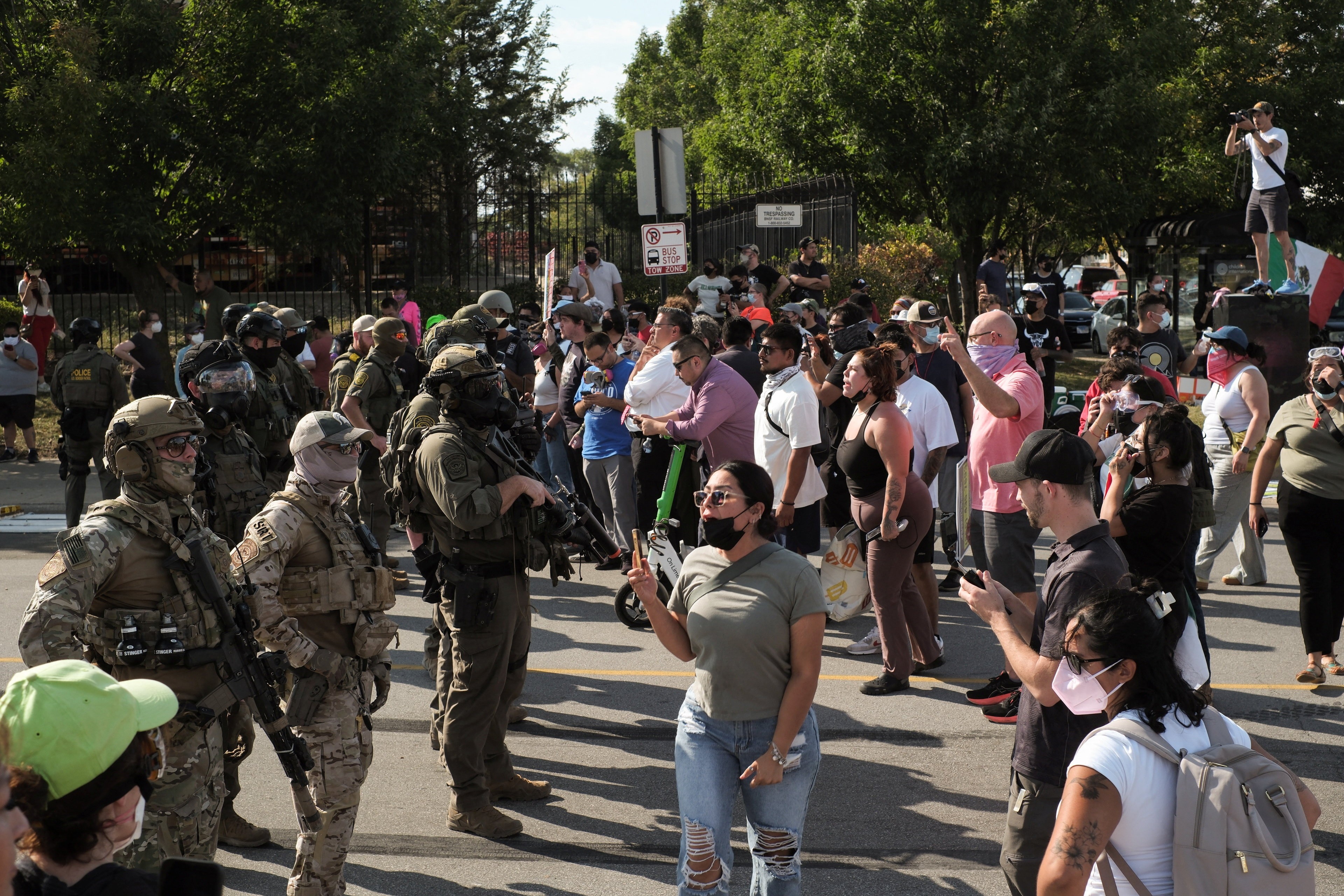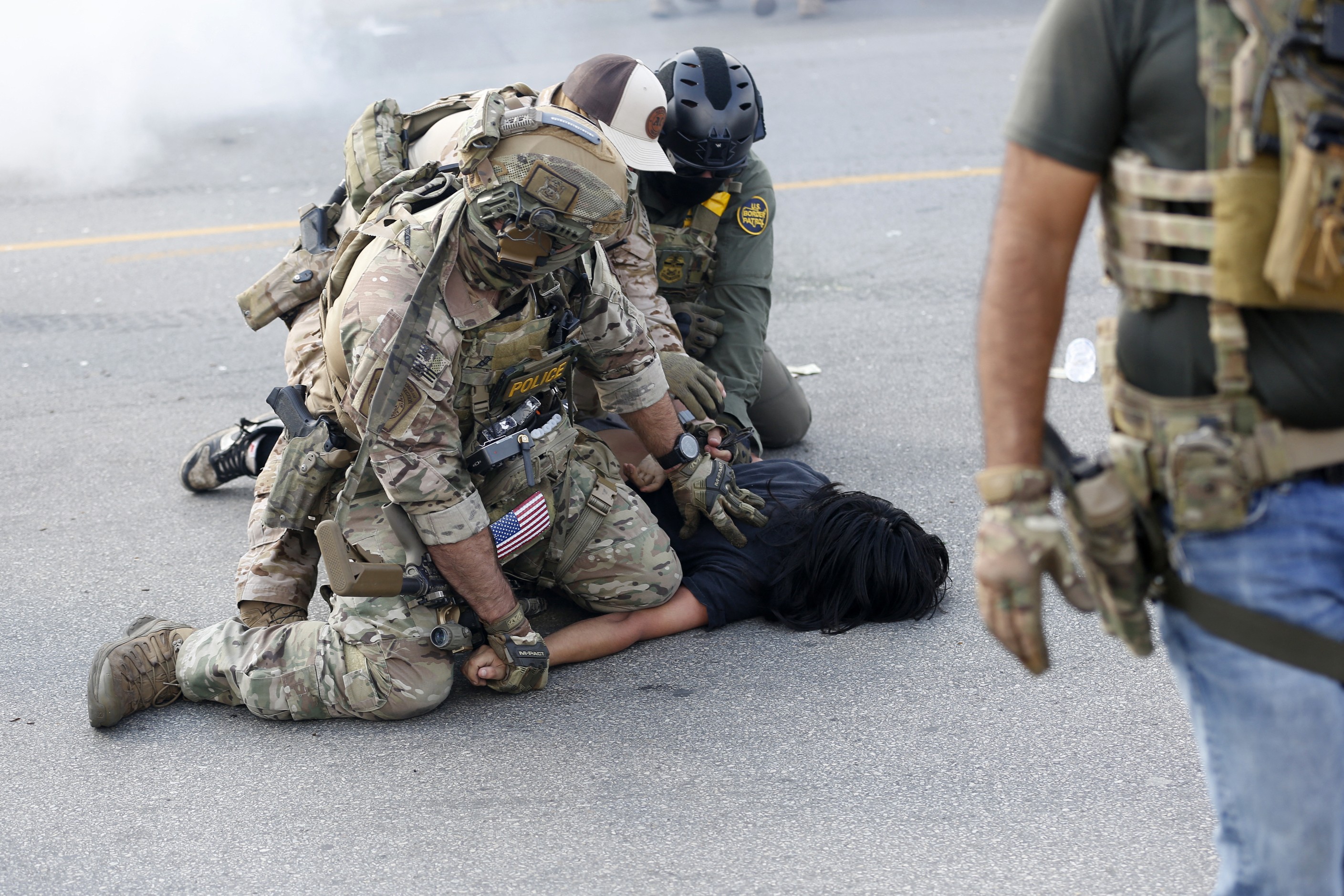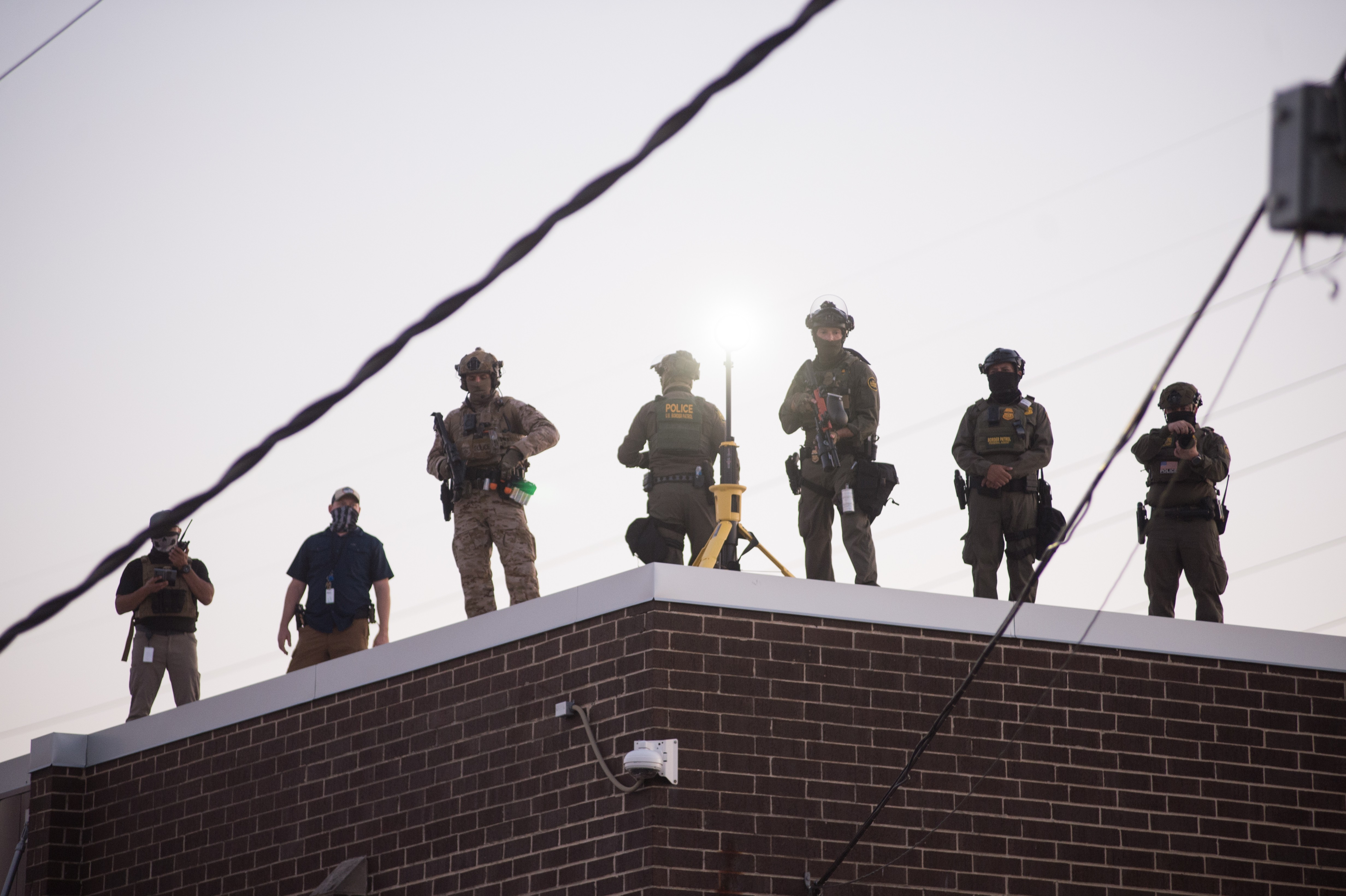When National Guard troops from Texas started to arrive in Illinois last week, I drove out to the Immigration and Customs Enforcement processing center on the outskirts of Chicago to get a better look at what the soldiers were sent to protect. The ICE building is just off the interstate, next to a pest-control company and several union halls. Protesters have been gathering here for weeks, so ICE covered the windows with plywood and closed off the street with jersey barriers and steel fencing. The facility looks not much bigger than a neighborhood hardware store, a vestige of a different era of immigration enforcement, when ICE wasn’t working for a president who wanted a million deportations a year.
Television crews were set up outside, but I found only two protesters. One was Nick Sednew, a 40-year-old musician and father of a preschooler who told me he has been coming here every few days to try to overcome a feeling of dread and hopelessness. He stayed in the designated protest area about two blocks from where officers were coming and going, and it seemed unlikely they would notice him or the sign he held above his head, which said: ICE Out!
Sednew said he lives in a mostly Latino neighborhood in northwest Chicago that has been hit hard in recent weeks by raids. “This is not really abstract or political for me. I’ve witnessed them kidnapping my neighbors,” he told me. It was as if he were describing a foreign occupation, but from the beginning, President Donald Trump has framed his Chicago operation as a military conquest.
In early August, Trump announced his plans on Truth Social with cartoonish imagery from Apocalypse Now, with the president appearing as Lieutenant Colonel Bill Kilgore, the film’s fictional U.S. commander who massacred Vietnamese villagers with napalm. Chicago’s skyline is behind him, shown as a flaming hellscape, with “Chipocalypse Now” scrawled across the bottom. “‘I love the smell of deportations in the morning’ … Chicago about to find out why it’s called the Department of WAR,” Trump wrote, adding emoji of helicopters.
Life seems to imitate social media in the current Trump era, and sure enough, Border Patrol agents in commando gear rappelled from a Black Hawk helicopter this month to raid an apartment building on the city’s South Side. They kicked down doors and forced residents from their beds at gunpoint, using plastic zip ties to subdue U.S. citizens and noncitizens alike. A few days later, agents shot and wounded a woman who works as a teacher’s aide at a Montessori school, whom they accused of ramming them with her vehicle. As the federal government’s crackdown intensifies, I’ve spoken with activists and ICE officials who are all worried about where this is headed.
Sednew, bearded and wearing a hiking cap, told me he wanted to choose his words carefully because he fears the government will target resisters like him. “They are like a bully who has someone in a headlock and saying ‘Stop making me hit you.’ They control every lever of power, and they’re using the power of the state to punch down, with vengeance and ill will, on innocent people.”
Department of Homeland Security officials say they’ve deployed to Chicago to save the city from immigrants who commit crimes. Chicago has long had a reputation for shootings and gang violence, but there is no evidence that the recent influx of immigrants has made the city more dangerous. If anything, it’s been the opposite: Chicago’s murder rate is down by more than half since a spike during the pandemic, and this summer the city recorded the fewest number of killings in 60 years.
As a stage for Trump’s top domestic-policy issue—mass deportations—Chicago is perhaps the biggest blue trophy among the American cities the president has threatened or already targeted. The city was among the first to adopt “sanctuary” policies that limit cooperation with federal immigration enforcement, back in 1985. It remains a Democratic Party stronghold, and the home of the Obamas, whose vision of multiracial liberalism remains the country’s main ideological antithesis to MAGA.
Trump seemed to hesitate after his Chipocalypse post, announcing he would order soldiers to Memphis and New Orleans instead of Chicago. But he pivoted back with no explanation a few weeks later, calling Chicago “the worst and most dangerous city in the World, by far.” He has assigned Texas National Guard units—who have earned a reputation for treating migrants harshly along the Mexico border—to deploy along with federalized Illinois troops. A district court has blocked the moves, for now, leaving Trump’s mobilization in limbo. At the heart of the legal dispute are the administration’s claims that it is facing a dangerous rebellion, enabled by Democratic leaders, that puts federal officers at risk and undermines the rule of law.
From where I stood with Sednew and the other protester, the threat to ICE seemed well under control. The village of Broadview, where the ICE building is located, has banned protests before 9 a.m. or after 6 p.m. The facility is barricaded and guarded by town police officers, alongside Cook County Sheriff deputies and Illinois State Police officers. Chicago police have played a similar role in the city, at times standing as a buffer between protesters and federal forces, but not assisting ICE.
Trump officials say they will not be deterred, and when DHS Secretary Kristi Noem visited the city earlier this month, she toured properties the administration is looking to acquire. “We’re not going to back off,” Noem told reporters. “We’re doubling down, and we’re going to be in more parts of Chicago.”

Every city targeted by Trump so far seems to resist in its own way. Protesters in proudly weird Portland, Oregon, have been mocking Trump’s “war zone” claims by dancing in animal costumes and riding bikes buck naked. In Los Angeles, where I went to cover protests in June, the crowds were large, angry, and more confrontational. Demonstrators stormed the freeway to block traffic, and some torched Waymo cars and hurled objects at police. California Governor Gavin Newsom and L.A. Mayor Karen Bass shared the crowd’s disapproval of Trump, but they deployed hundreds of California Highway Patrol and LAPD officers to keep a lid on looting and stave off wider unrest that might vindicate the president’s troop deployment.
In Chicago, city officials and neighborhood activist groups have been more disciplined, coordinating closely on efforts to slow ICE’s “Operation Midway Blitz.” Illinois Governor J. B. Pritzker and Chicago Mayor Brandon Johnson are fighting the National Guard deployment in court, and Johnson has declared city property off-limits to ICE, though it’s unclear how he’ll be able to enforce the ban. When Noem tried to use the bathroom inside the Broadview municipal building earlier this month, staffers wouldn’t even open the door.
Abigail Jackson, a spokesperson for the White House, told me in a statement that Pritzker and Johnson were “failed leaders” and “Trump-Deranged buffoons” who “would rather allow the violence to continue and attack the President for wanting to help make their city safe again.”
Many of the street-level activists I spoke with are working under the leadership of a decades-old group, the Illinois Coalition for Immigrant and Refugee Rights, or ICIRR, which everyone pronounces as “ICER.” It sounds like a brand of antifreeze. ICIRR and other groups have tried to pressure businesses to block ICE from their property and have organized “Rapid Response” volunteer brigades that quickly deploy to locations where ICE officers attempt to make arrests. They document the encounters and hand out legal-aid information.
The activists have a tip line to report sightings and share vehicle descriptions and license-plate numbers. Once ICIRR activists verify the information, they post it to social media. The warning system identifies when a neighborhood is hot, so worried residents can stay indoors or away. When ICE is on the move, some volunteers will follow in cars, honking their horns and blowing whistles to create a rolling alarm system.
As ICE rushed into the city’s Avondale neighborhood in northwest Chicago last week, volunteers gathered on a busy corner with signs telling motorists Cuidado! La Migra Está Cerca (“Watch out! ICE is nearby”). I spoke with Emmeline Prokash, who had propped up a warning sign on her stroller after dropping off her son at preschool. “What they’re doing is disgusting,” said Prokash, a gardener and stay-at-home mom wearing a whistle around her neck. “It’s not right. They’re just abducting people. They’re separating families. Kids are afraid to go to school. These are my neighbors.”
A helicopter circled overhead, and an activist with a telescope said he spotted the U.S. Customs and Border Protection seal on the fuselage. He had two whistles dangling from his neck and a small rearview mirror—typically used by cyclists—mounted on his sunglasses.
Another neighbor, Damien Madden, said he’d seen officers in plainclothes that morning chase down a man in a red T-shirt, stuffing him into a white minivan. They were gone in less than a minute. “I grew up in the city, and I’m used to cops doing what cops do,” Madden, 52, told me. “But at least they come up and identify themselves. There’s due process. But to see someone just get chased and snatched, it’s crazy.”
Passing motorists honked in support, and others pulled up to trade info. Watch out for a silver Jeep Wagoneer, one driver said. DHS and ICE officials say that activists like these are illegally obstructing them from doing their jobs and that this type of tracking has led to death threats and doxxing attempts. ICE officers typically work in plainclothes, but the agency has allowed them to wear masks as a form of identity protection.
Officers cannot force their way inside a private residence without a judicial warrant, and the technique known as “knock and talk,” in which officers try to persuade suspects to open the door, has been neutralized by activists’ know-your-rights pamphlets. That has left officers relying more and more on street arrests. An opinion by Supreme Court Justice Brett Kavanaugh last month gave ICE officers a green light to continue relying on factors that include ethnicity and physical appearance when determining who they question.
Brian Rodarte, the manager of a medical-supply company in the neighborhood, told me officers stopped one of his drivers that morning and let the man go after seeing his driver’s license. Then the officers followed him to the company’s employee lot and tried to drive in. Rodarte quickly shut the gate. “All of our employees are American citizens, but we don’t need guys being racially profiled and detained,” Rodarte told me.
Rodarte, who is half Mexican and half Irish, told me he sees both sides of the immigration debate. He has no problem with ICE arresting violent criminals, he told me, but they should handle it the right way. “What they’re doing is against our rights and totally unconstitutional,” Rodarte told me. “They’re just racially profiling anyone who looks Hispanic.”

In Chicago, as in L.A. before it, the federal mobilization is led not by career ICE officials but by Gregory Bovino, the Border Patrol chief of the agency’s El Centro Sector, more than 2,000 miles away in California. Bovino, who is now also the “at-large commander” for Trump’s crackdown, has become a star of MAGA social media, and in Chicago he travels with a film crew, making DHS propaganda videos. In one, he patrols the city waterfront on a boat, in footage that builds to a glittering shot of Trump Tower. Another shows Bovino buying energy drinks at local markets and high-fiving Black residents, set to the Bee Gees’ “Stayin’ Alive.” Its apparent aim is to exploit the Black-brown tensions in Chicago that worsened during the Biden administration, as record numbers of migrants—especially Venezuelans—poured into the city, some on buses sent by Texas Governor Greg Abbott, a Republican. Some Black residents grumbled that the new arrivals received benefits that should go to needy American citizens, and Trump advisers, including Stephen Miller, have tried to fan those resentments to woo Black support.
At Teques Bites, a small Venezuelan cafe in Avondale, I met owner Andry Garcia, who arrived in Chicago five years ago. He told me the ICE raids were sweeping up some of the “bad” Venezuelans—criminals—but also many others who were law-abiding and had pending asylum cases, or whose temporary legal residency had been taken away by the Trump administration.
Garcia said his sales have been cut by more than half since ICE arrived, and he’s struggled to find delivery drivers brave enough to be out on the street, where they’d be easy ICE targets. Last year Garcia acquired a second, larger location with dreams of expansion, but his plan is now frozen. “We were just about to open when the whole ICE thing started,” he told me.
Trump officials claim they are hunting members of Venezuela’s Tren de Aragua gang, which the president has designated as a foreign terrorist organization. The administration has used that label to conduct lethal attacks in the Caribbean on boats allegedly linked to the gang. The gang’s presence in Chicago was used to justify the commando raid that Bovino’s teams carried out on the apartment building in Chicago’s South Shore neighborhood. DHS officials said they made 37 arrests, but they have not released names or provided evidence of suspects’ ties to Tren de Aragua. DHS and ICE did not respond to my inquiries for more information about the raid.
The apartment building was mostly deserted when I visited it last week, though a few residents remained. Shards of broken windows littered the exterior, and the entranceway reeked of cat urine and rotting trash. Prior to the raid, the building’s residents were a mix of Black tenants, many of them destitute, and newly arrived Venezuelan families. In recent years, as code violations accrued and some occupants stopped paying rent, the building spiraled deeper into squalor and ruin, residents told me.
The lock on the front door was broken, and inside, the hallways, stairwells, and abandoned units had become dumping grounds for trash. I held my breath and stepped over rat carcasses through dark corridors swarming with flies. Fresh plywood covered some of the units hit by the raid, but others remained open, lacking doors. I could see rotting food, feces, and bloodstains along the floors amid broken furniture and diapers. An abandoned bicycle in one hall had training wheels, and a child’s stuffed animal, a pink pig, had been left behind in the stairwell. The building had clearly been in a bad state even before Bovino’s forces smashed their way through.
“You see this shit? This is how we live here,” one of the residents I met, Archie Collins, told me.
Collins, 59, said he’d moved into the building with his older brother five years ago, after losing his job as an inspector at a factory making parts for Ford. His brother received federal housing vouchers, but he died six months ago. Collins has lived alone since then. His electricity came through an extension cord plugged to another unit. His pants were torn. He’d been asleep when Bovino’s forces stormed the building, pulling residents out of their apartments at gunpoint. Collins, who is Black, tried to show them his Illinois ID card. “They didn’t give a shit,” he said.
Collins told me he felt terrorized and humiliated. “They didn’t come here for me. I don’t talk like a fuckin’ Venezuelan,” he said, fuming. His front door had been smashed in.
When we finished talking, Collins asked for money, and told me he hadn’t eaten all day. I said that, as a journalist, I could not pay for interviews, but I would be happy to buy him some food. We drove to a nearby supermarket, and Collins went up and down the aisles, filling his cart with bread, ramen noodles, milk, hot dogs, and pastries. I realized that no one from the federal government had gone to the building after the raid to check on the elderly Americans who lived there, to see if any of them needed help, or to apologize for handcuffing them in the middle of the night.
As we passed the freezer case, Collins asked me if he could get ice cream. He picked out a pint of fudge swirl and tore into it as soon as we got back in the car, using the lid as a spoon. Back outside the apartment building, he bundled the grocery bags in his hands and raced inside as if someone might try to rob him.

Images from Chicago this week show federal forces behaving aggressively: pointing weapons at unarmed protesters, lobbing tear gas in residential neighborhoods, arresting a 15-year-old. Border Patrol agents tackled and handcuffed a veteran producer for the Chicago television network WGN, who said she was merely walking to the bus stop. Agents claimed she threw an object at their vehicle, but she was released without charges. The ledger of violence has been mostly one-sided.
One afternoon last week, I went to another Chicago neighborhood that had been in the news, Humboldt Park, to speak with Jessie Fuentes, the local alderperson. Fuentes, 34, appeared in a video that went viral, showing her asking an ICE officer in a hospital emergency room if he had a judicial warrant. The officer violently yanked her arms behind her back and cuffed her.
As we walked along West Division Street in Humboldt Park—the “Puerto Rican mecca of the Midwest,” Fuentes joked—passing drivers honked in support, and residents who’d seen the video came up to hug her. At least once a week, Fuentes said, she walks through the neighborhood, passing out know-your-rights pamphlets. She helps coordinate Rapid Response brigades, and she told me she’s helped arrange care for children whose parents have been taken by ICE, and helped recover vehicles that were left idling in the street after owners were seized so fast they didn’t have time to park.
Graciela Guzmán, a 35-year-old Illinois state senator who represents the district, joined Fuentes, and told me one of the most frustrating things she hears from the administration is that the city is a war zone. “They’re the ones using tear gas and rubber bullets, and breaking windows,” she said. “They’re the ones bringing a war zone to Chicago.”
On the day Fuentes was handcuffed, she told me, she’d received a call from the hospital administrator. ICE officers were inside the emergency room, they told her, and patients were scared. The officers had arrived with a man who fell and broke his leg after ICE raided the parking lot of a nearby Walmart, Fuentes said.
In the video, she firmly insists to the ICE officer that the man “has constitutional rights.”
“No, no,” the officer says. “You need to leave.”
The clip ends with Fuentes being led out of the building in handcuffs. Fuentes said a Border Patrol agent arrived in a white truck to pick her up, but told the officers to remove the handcuffs when he found out she was an elected official.
Enrique Espinosa, an attorney for the man with the broken leg, said his client remains hospitalized under 24-hour watch by ICE. Officers have refused to let the lawyer speak with the man, claiming they have not finished processing him.
DHS and ICE did not respond to my inquiries about Espinosa’s client or the circumstances leading up to the incident.

The legal fight over the deployment of the National Guard troops hinges largely on the credibility of the government’s claims about the threats to federal forces in Chicago. At least two videos have circulated showing officers failing to make an arrest as protesters gather and try to free suspects from custody. The incidents do not show protesters attacking officers, but DHS officials say assaults are soaring and gangs in Chicago have bounties on federal officials. Federal prosecutors charged an alleged Latin Kings member last week who had supposedly put out a hit on Bovino, offering $10,000.
The federal agents have been quick to draw their guns, and they have shot two people in Chicago already. Silverio Villegas Gonzalez was shot and killed on September 12 as he attempted to drive away while an ICE officer was reaching into his vehicle. DHS initially claimed officers were severely injured in the incident, but body-camera footage released later showed that was not true. Villegas Gonzalez, 38, a father of two U.S.-born sons who arrived from Mexico in 2007, worked as a cook and had no criminal record other than years-old traffic violations, according to Reuters. DHS said it is investigating the incident, and that the officers had feared for their safety.
Three weeks later, border agents shot Marimar Martinez, a 30-year-old day-care worker who had been driving behind them, honking her horn, and yelling “la migra!” out her windows. DHS said that the agents had defended themselves after Martinez rammed them and that they were trapped “by 10 cars.” On Friday, federal prosecutors charged Martinez and another defendant with impeding a federal officer while in possession of a deadly weapon.
Christopher Parente, Martinez’s attorney, told me DHS’s version of the incident is contradicted by body-camera footage captured by one of the three agents in the vehicle. (The two others had their cameras turned off, he told me.) The agents were not, in fact, boxed in, he said, and there appear to have been only two vehicles following the officers, not 10. The agent in the back seat, who Parente said had his finger on the trigger of the rifle, can be heard saying “Do something, bitch” just before the collision. The footage shows the driver yanking the steering wheel to the side as the crash occurs, and the agents jump out and start firing. Martinez was stuck five times but managed to drive away and call an ambulance, Parente said. Martinez told him she was still making car payments on the Nissan Rogue she was driving, and wouldn’t have used it as a battering ram.
Martinez had a handgun in her purse, which she carries for self-defense, and for which she has a valid concealed-carry license, Parente said. The federal indictment does not claim Martinez brandished the weapon at any point. When federal agents arrested Martinez and tried to take her to a detention facility, the staff refused to admit her because her bandages were soaked through with blood, her lawyer said. She had to be taken back to the hospital, and a judge ordered her release from custody a day later.
As U.S. District Judge April Perry granted Illinois leaders a temporary restraining order to block the National Guard deployment on Friday, she wrote that DHS officials’ perceptions of events in Chicago “are not reliable.” (Trump officials have appealed, and the next hearing is scheduled for October 22.) Protests outside of the ICE building in Broadview have never drawn more than 200 people, she noted, and did not meet the threshold of a “rebellion” that would necessitate federal troops. The deployment of the National Guard to the facility “or anywhere else in Illinois,” Perry wrote, “will only add fuel to the fire that Defendants themselves started.”
The post The Conquest of Chicago appeared first on The Atlantic.




